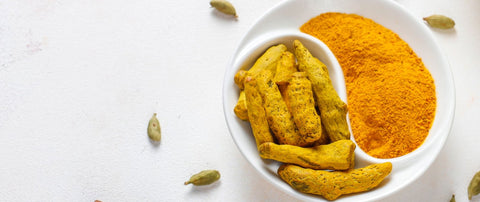Turmeric: detoxifying, digestive stimulant and even beneficial for cancer and Alzheimer's? The bright golden spice is said to have special healing powers. We get to the bottom of this and find answers to the question: How healthy is turmeric?
Inhaltsverzeichnis
Turmeric: An Ayurvedic medicinal plant
Turmeric has been valued as a spice and medicinal plant in Southeast Asia for over 4,000 years. The golden spice is also very popular in India. According to Ayurvedic cuisine and medicine, a healing effect has been attributed to it for thousands of years. This is certainly one of the reasons why turmeric is an important ingredient in every curry dish. In the Middle Ages, the root reached Europe via the Silk Road. Because of its colouring properties, it was also called "Indian saffron".
Most people know turmeric in powder form. This is obtained from the rootstock of the turmeric plant. Turmeric belongs to the ginger family and actually looks somewhat similar to ginger. It can be used fresh, dried or powdered and tastes mildly spicy and slightly bitter.
Today, turmeric is also becoming increasingly popular in our latitudes. This is not only due to its bright colour and the growing enthusiasm for healthy Indian and Asian cuisine. Turmeric is also said to have health-promoting properties. For example, it is said to have an anti-inflammatory effect, help with digestive problems and promote recovery from cancer and Alzheimer's disease. But what is the truth of these statements and how healthy is turmeric really?
Curcumin: the golden yellow active ingredient
The health-promoting effect of turmeric on the body is attributed in particular to a biologically active plant substance in the root: Curcumin.
Turmeric consists of essential oils, protein, sugar and about 5% of the valuable curcumin. The tuber owes its bright yellow colour to curcumin. It is therefore used in the food industry as a natural colouring agent under the designation E100.
image: foods coloured with turmeric, such as rice or mustard.
Unfortunately, curumin is not very well absorbed by the body. A large part of it is simply excreted again. This is also called limited bioavailability.
Certain substances and processes can improve the absorption of curcumin in the body. One of these is piperine. This can increase the bioavailability of curcumin about 20-fold. Piperine is a natural component of black pepper.

The effect of turmeric
As a spice, turmeric can provide colour on the plate. But the question arises: How healthy is turmeric? Much research has been done on the ancient knowledge from traditional medicine in recent years and countless articles have been published. Many positive effects of a diet rich in turmeric have not yet been sufficiently clarified medically. However, some studies point to healthy properties of turmeric for the human body.
Turmeric: Healthy for stomach and intestines
There is one undisputed effect for which the spice has also been known in Ayurveda for thousands of years. Turmeric can have a positive effect on the marges and intestines. The Committee for Herbal Medicinal Products (HMPC) of the European Medicines Agency (EMA) confirms: Turmeric can help with bloating, flatulence or sluggish digestion. Spicing up the diet with the colourful spice can therefore also help to get the digestion going. Especially when we eat fatty foods.
Turmeric: Good for inflammation
Studies also suggest that curcumin has an anti-inflammatory effect similar to the drug cortisone. Thus, it could help the body to activate its self-healing powers and counteract inflammations such as those of the gums or acne. In India, turmeric has been used for a long time to treat precisely these complaints.
Turmeric: Promotes cell protection
Experiments in the test tube have shown that curcumin is a radical scavenger. This means that it neutralises aggressive chemical compounds. In this way, curcumin can protect cells. Further laboratory experiments suggest that it inhibits the growth of artificially created cancer cells. However, such results should be taken with a grain of salt. This is because extensive serious studies on human cancer patients are currently not known. The same applies to other serious diseases.
Recipe: Golden Milk
A true turmeric booster is turmeric latte, also called golden milk. The recipe is quick and easy. And it's also super tasty and healthy. All you need for two cups of turmeric latte are:
- ½ litre cow's milk or almond/soy/oat milk
- 2 centimetres of ginger
- 1 teaspoon turmeric or 1 capsule (opened) CLAV turmeric extract
- 1 teaspoon of cinnamon
- 1 pinch of black pepper
- 1 to 2 teaspoons honey or agave syrup (vegan alternative)
Slowly heat the milk in a saucepan. Wash, peel and grate the ginger very finely. Now add the ginger, cinnamon, honey and turmeric as a spice or the contents of the capsules to the pot and stir. Now simmer the milk at a low temperature for about 5 minutes until it turns dark golden.
It's ready: now you can pour your turmeric latte into two cups and garnish with black pepper.

Turmeric for those in a hurry
Even though a golden milk is incredibly delicious and beneficial, we don't always have time to prepare it. A practical solution to this problem is to incorporate turmeric capsules into your diet. These allow you to consume high doses of curcumin safely and without side effects.
CLAV's turmeric extract capsules not only guarantee a high and safe amount of curcumin for your diet. They also combine curcumin with piperine from black pepper.




 DE-ÖKO-006
DE-ÖKO-006
